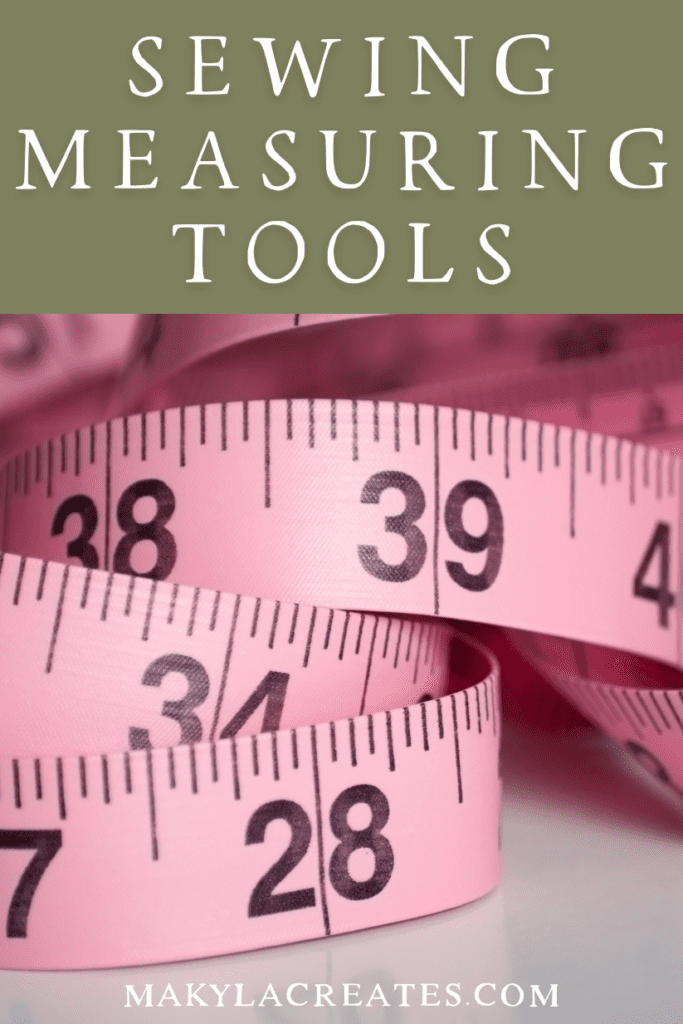If you’re new to sewing, getting the right measurements is super important in both pattern-making and sewing. Luckily, I’m here to help you pick the best tools for the job!
Using the right sewing tools can really elevate your work from homemade to professional-looking. Measuring tools are just as important as marking and cutting tools. Whether you’re been sewing for years or just starting out, using the right tools, like rulers and measuring tapes, will make your sewing experience much easier and enjoyable.
This guide covers all the different measuring tools you might need, like rulers, gauges, and tape measures, and I’ll explain when to use each one.

As an Amazon Associate, I earn from qualifying purchases. Read my full disclosure here.
To kick off your sewing journey, I recommend checking out these informative posts first:
- Learn how to sew – Ultimate guide for beginners
- Best sewing machines for beginners
- Types of fabrics
- How to cut out fabric
Sewing Measuring Tools
Tailors Measuring Tape
One of the most versatile and commonly used measuring tools is the tailor’s tape measure. It’s super handy and easy to use. It’s a flexible tape made from fibreglass that is marked with measurements in both inches and centimetres. Standard 150cm (60-inch) tape measures are usually perfect for most sewing projects.
Tailor measuring tapes are great for taking body measurements, determining fabric lengths, and measuring curved or irregular shapes. They’re also portable, so you can take them anywhere you go.
When you’re looking for a tape measure, make sure you choose one made from durable materials with clear markings for accurate readings.
Shop Tape Measures
Rulers
Other essential tools for your kit are rulers and yardsticks. They come in different lengths and are typically made of metal, plastic, or wood. Rulers are shorter, usually around 30cm (12 inches), while yardsticks (or metre rulers) are longer, measuring 91cm (36 inches) or more.
These tools come in handy when you need to measure and mark straight lines. They’re great for pattern drafting, measuring fabric widths, and drawing straight lines for cutting or sewing. Make sure you choose rulers and yardsticks with clear markings and sturdy construction to ensure accurate measurements.
Measuring Gauges
Measuring gauges are handy tools that help you get precise measurements. There are different types of measuring gauges that are used for different projects. Some are for sewing, while others are for pattern making. Let’s look at some of the most popular ones!
1. Seam Gauge – there are a few options when it comes to seam gauges, it’s a ruler-like gadget with a sliding marker that’s perfect for measuring and marking things like seam allowances, hems, and buttonhole placements. With this tool, you can easily replicate measurements and ensure everything is consistent throughout your project.
When quilting or sewing, a square-like style with various measurements can be helpful for checking smaller measurements.
Shop Seam Gauges
2. Hem Gauge – have you heard of a hem gauge before? It’s a handy tool for measuring and marking hems, especially curved ones. With its curved shape, it’s easy to use and provides multiple measurement options for different hem depths. Other options include clips with measurements that make folding and sewing a hem much quicker than using a ruler!
Shop Hem Gauges
3. French Curve – a French curve is a measuring tool that can help you create super smooth and flowing lines when you’re designing or altering patterns. It’s brilliant to use when you’re working on garments that have curved elements, like armholes or necklines. I use mine all the time when I’m drafting new sewing patterns for my sewing pattern shop.

4. L-Square – an L-square is an L-shaped ruler used for drafting perpendicular lines and right angles. It’s useful for pattern drafting, ensuring precise and accurate angles in your designs.

5. Set Square – I love using my set square when drafting sewing patterns! It’s a clear plastic, triangular-shaped ruler with two sides that form a 45-degree angle. It’s perfect for drawing or measuring lines that are perpendicular to each other (that’s 90 degrees!). You can use it to create straight lines for hems, add seam allowances, or draw perpendicular lines for your patterns.
Sewing Measuring Tools Conclusion
There are lots of sewing measuring tool options to choose from, like tape measures, rulers, and seam or hem gauges. By choosing the right tool for your sewing projects, you’ll get more accurate and professional results.








